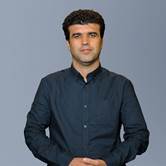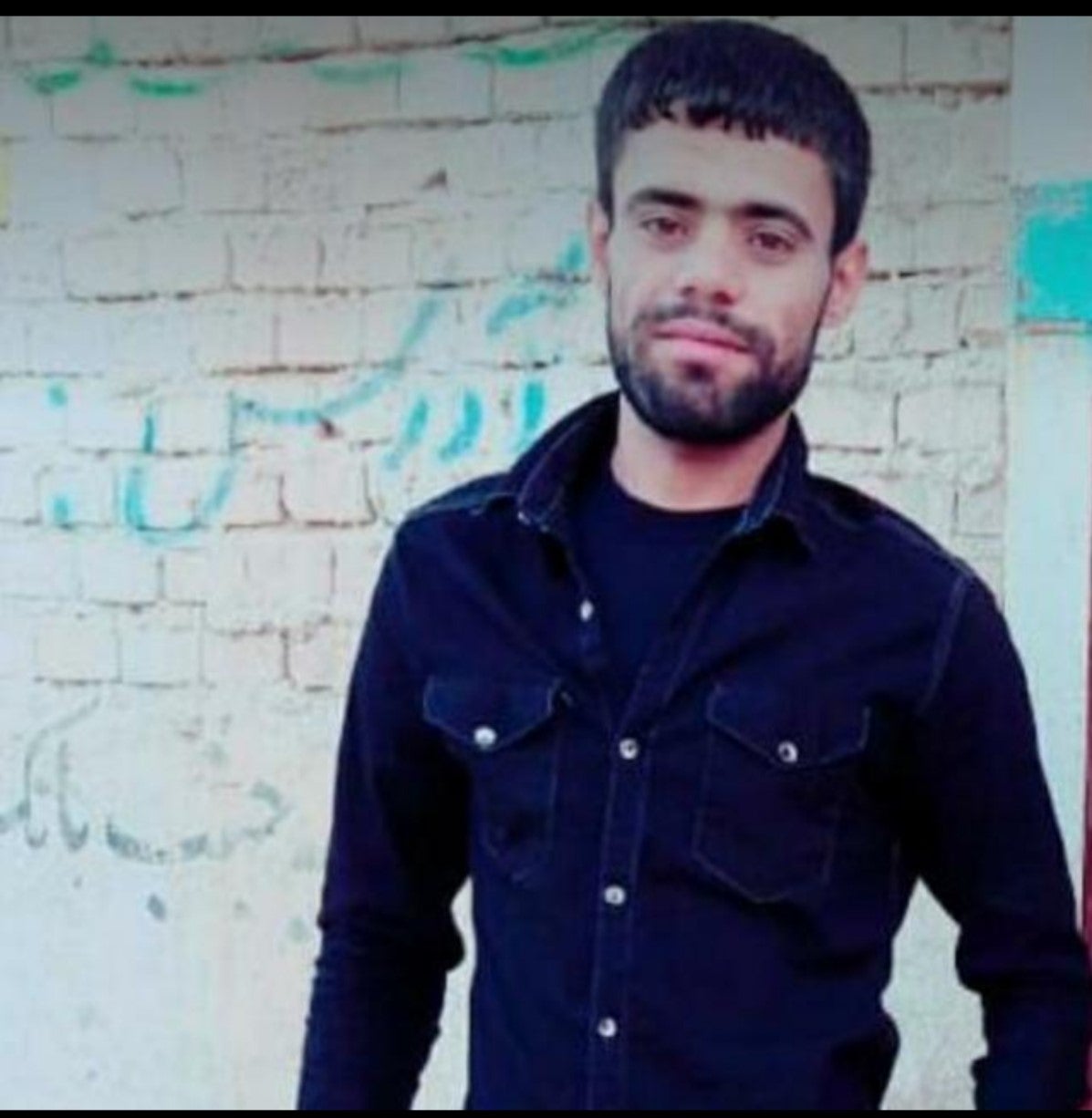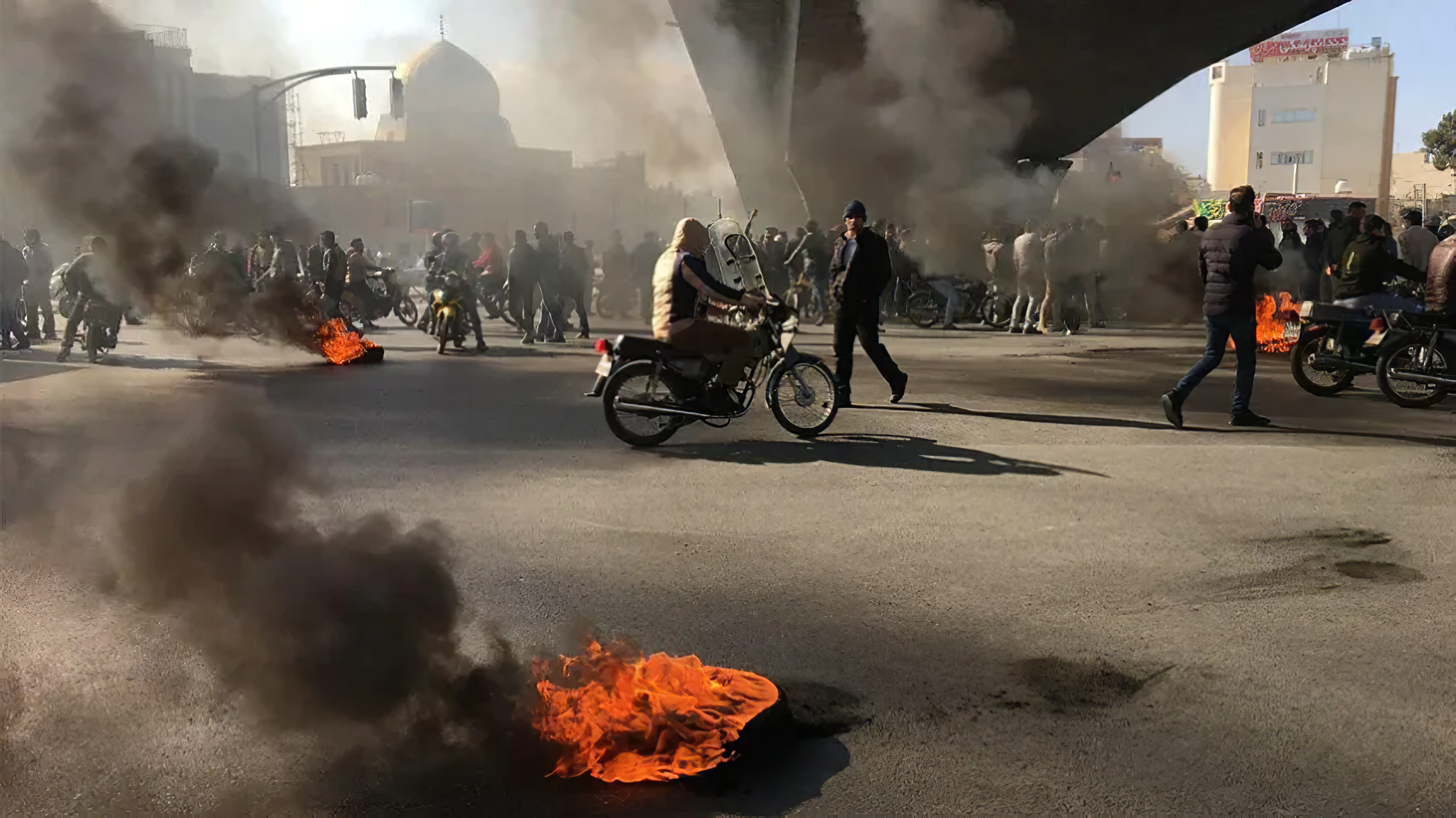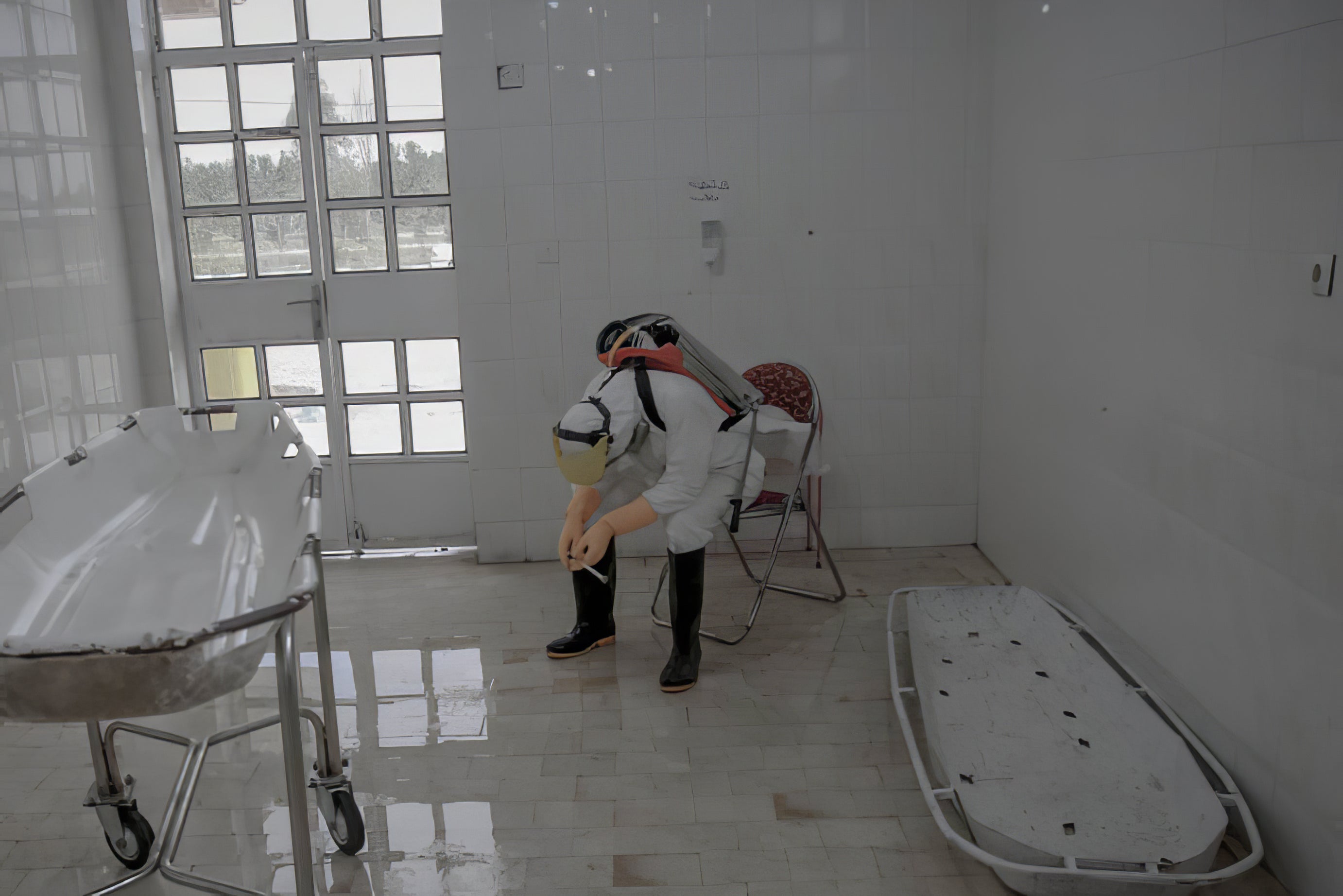
A man mourns as more are buried in Ahvaz, Iran on April 6, 2020. Photo: Mohammed Ahangar/ Fars News
ERBIL, Kurdistan Region—Ahmad Talaqani was sitting in his overcrowded prison cell one morning in late March when whispers started circulating among the inmates. The ward was infected with the gossip of what was going on in distant Tehran, around the world, and at other Iranian prisons. Rumors of a virus that does not distinguish between the poor and the prime minister. Rumors that they might be released. But as a member of Iran’s Arab minority, Ahmad – or Fares, as his family calls him – doubted he would be privileged enough to benefit from such mercy.
Days go by in prison like water evaporating after the rain. In Iran, it is normal to be jailed for such a charge as changing religious sect, from Shiite to Sunni Islam. It is even normal for news from the outside world to filter into the prison from a visitor, or a guard who can be bribed to smuggle in a phone. What was not normal was what they said: news of something spreading, something the Iranian state could not control.
When it started to become apparent that the deadly and treatment-resistant strain of the coronavirus had reached all corners of society, the prison became like a powder keg waiting to blow. Restless prisoners feared the virus could already have made its way into the facility, and they would be powerless to stop its spread.
Paranoia took hold when three men were taken out of the prison, showing signs of respiratory problems. Suddenly, escaping the virus seemed as impossible as escaping jail. So in the heat of the crisis, Fares made a choice – why not try both?
While Iran is gripped by the COVID-19 outbreak, the authorities' hold over its prisons is slipping. UN officials say they are “horrified” at reports of brutality emerging from the country’s overcrowded prisons as the situation spirals out of control. Half a dozen riots have been reported in the past three weeks. At least a hundred prisoners have escaped, and some outbreaks have turned deadly.
“It is abhorrent that instead of responding to prisoners’ legitimate demands to be protected from COVID-19, Iranian authorities have yet again resorted to killing people to silence their concerns,” said Diana Eltahawy, Amnesty International’s Deputy Regional Director of Middle East and North Africa. Amnesty estimates lethal force used against prisoners killed 36 people in eight incidents.
It was during one of these riots in a detention facility in the oil-rich province of Khuzestan, bordering Iraq, that Fares went missing. At Sheyban Prison, twenty kilometers northeast of the metropolitan city of Ahvaz, around 200 prisoners rushed the guards on the night of March 31st, lighting fires and clashing with their jailers. Others barricaded themselves in the ward, making demands that they be freed. Guards started firing tear gas from the roof into the prison to smoke out ward-occupying inmates. Some lit fires and clashed with personnel, throwing whatever they could find at the guards, while others waited for the chaos to be over so they could surrender and escape further punishment. When they managed to wrest control of the entire ward and make it out into the courtyard, reinforcements were brought in to quell the unrest with live ammunition. Fares was hit, and fell. He lay unconscious on the ground until the bedlam subsided.
Desperate for news about their son, his family waited outside the prison for two nights, propped up in their sleep by the fence surrounding the facility. Word eventually came through that Fares was recovering at the Imam Khomeini hospital in Ahvaz, and his family managed to visit him on Thursday. They found him wearing baggy trousers with no shirt and chained to a bed, Abdul Hadi Majid al-Ahwazi, a cousin of Fares told Rudaw English on Friday. “He was wounded in the chest and abdomen with pellets from a shotgun rifle, and one eye was also wounded,” he said. Members of the Arab minority refer to the city as Ahwaz, the pronunciation in their own language.
Some of those currently sitting in Iran’s prisons were arrested during a wave of mass protests sparked by fuel price hikes in November last year. When the government of President Hassan Rouhani tripled the price of petrol, hundreds of thousands took to the streets. The protest in Khuzestan, the Kurdish areas and in Baluchistan were particularly intense. The government’s response to the protests was heavy-handed — at least 500 protesters were killed and tens of thousands of protesters were detained.
Fares’ cousin Hadi, himself a former political prisoner who now lives outside Iran, believes that at least 11 people may have been killed in the two prisons in Ahvaz where the riots took place.
Unlike several other inmates who perished in the riot, Fares was lucky to escape with injuries. “No one can get the exact number of people killed or wounded because there are tight security measures in place,” says Hossein Bouazar, the spokesperson for Ahwazi Center for Human Rights.
The Europe-based center monitors the human rights situation in the Arab areas of Iran. “The two prisons where the riots took place are very overcrowded and the families are too scared to speak out,” Bouazar says. “People are still frightened after the authorities used extreme force to quell the protests in November.” The Center has established the identity of at least four prisoners who were killed in the riots with around two dozen inmates wounded but they say the real number of vicitms is much higher.
“It is not clear what happened, what we know is that these prisoners were alive before the riots and their families were told they were dead after the riot, the authorities did not say how they passed away,” Bouazar told Rudaw English.
Asghar Jahangir, the head of Iran's Prisons Organization said in a televised address on Monday that the riots were a ploy by the enemies of the country and refused to say how many prisoners were killed in the riots, or from COVID-19.
Deprived provinces under the greatest pressure
Iran’s ethnic minority regions are a familiar paradox of inequalities. Ruled by a clerical Shiite government, faith practice by the country’s Baha'i and Sunni Muslim religious minorities is stifled, as are cultural and political activities among the country’s Azeri, Kurdish, Arab, and Baluch ethnic minorities. Chronic government underinvestment is part and parcel of their difficult existence.
Khuzestan province is home to many of the country’s oil fields, and also its poorest citizens. At the coastal entrance to the Persian Gulf, it is the beating heart of the nation’s economy, its oil corridor to the world. Most of the country’s petrodollars come from Khuzestan, but even as fresh new oil fields are discovered, little has been done to improve the lives of the predominantly Arab minority who live there.
On the other side of the country is Iran’s rural Sistan & Baluchistan region, bordering Pakistan and Afghanistan, where its predominantly ethnically Baluchi population live in rural areas neglected by state services. More people live below the poverty line than above it, and the infant mortality rate for newborn babies is the highest in the country. Even state-affiliated outlets report that more than one-third of the population does not have access to potable water. The IRGC has total control over security in these provinces. Local security forces are subservient to the guards, mainly due to the simmering Sunni insurgency in the area that they are targeted by.
Human rights activists say there is no independent information available about what is going on in the prisons across the province, where thousands of prisoners are held. The conditions inside prisons and the human rights situation in the province are drastically underreported.
“What we know is that special forces have been brought in and they have been spotted around the Zahedan prison,” Habibolah Sarbazi, a Balochi human rights activist, told Rudaw English on Saturday. “It’s been two months since we have heard from out [our contacts in prisons] in Zahedan, Zabol or Saravan.”
Human rights activists in the ethnic minority areas fear the virus could take countless inmate lives in areas where the security forces impose an iron-clad social rule.
In these provinces, the existing poverty and social misery accelerated the November wave of protests. Riot police scrambled to put down protests that spontaneously broke out in cities throughout the country last November. But in provinces where Iran’s minority Arab, Kurdish and Balochi populations live, the Islamic Revolutionary Guards Corps (IRGC) took especially heavy-handed charge of the situation, using armoured vehicles, heavy machine guns – and in Khuzestan province, tanks – to put down the protest.
Javaid Rehman, UN Special Rapporteur on the human rights situation in the Islamic Republic of Iran said in March that he was alarmed by detention conditions in the wake of the November protests. “The Special Rapporteur heard evidence that security and intelligence officials, including from the Ministry of Intelligence and the Islamic Revolutionary Guard Corps, have in many cases prevented access to medical care for detainees and prisoners, or made medical attention or transfers to hospital conditional upon confession,” Rehman said. “The Special Rapporteur reiterates the concerns expressed by the Secretary-General about the conditions of detention, including reports of ill-treatment, efforts to extract forced confessions and denial of access to medical care.”
Sarbazi, who lives in exile outside Iran, estimates that there are 3,000 to 4,000 prisoners including political ones in Zahedan prison, in Baluchistan’s provincial capital. “We know that the prison is very overcrowded and we have had reports of prisoners being given a blanket to sleep in the corridors,” Sarbazi said.
President Rouhani claimed on Sunday that some provinces, including Sistan & Baluchistan, holds a “white” status — the government’s lowest risk rating for COVID-19. But this claim has been rejected by members of his own government. “By announcing that the situation in Sistan and Baluchistan is white, it is clear that apparently the President has no clue about the situation of this disease in the province,” Hossein Ali Shahriari, a member of parliament for Zahedan who lost his sister and his nephew to the pandemic said on Monday.
A senior health official in the province said on Monday that the rate of new infections had more than doubled in recent days. In the absence of treatment options, nearly 300 people throughout the country have been poisoned after consuming methanol, believing that the industrial-grade chemical cures the virus.
The COVID-19 pandemic has caused havoc across Iran which has become the epicenter of the virus in the Middle East. The pandemic has killed nearly 4,000 people in the country, with close to 65,000 infected as of April 8. The virus was first reported in the religious city of Qom but authorities now admit that it was making the rounds in the country much earlier. Delayed and haphazard in their implementation, measures to stop the virus quickly spreading to other parts of the country failed.
Death under torture and prisoners escaped in Kurdish areas
In Iran’s Kurdish-majority areas, including the West Azerbaijan, Kermanshah, Kurdistan and Lorestan provinces, there have been just over 300 deaths and close to 3,400 cases confirmed according to tally from the government and Kurdish sources.
The head of Iran’s judiciary, Ebrahim Raisi, said on March 29 that some 100,000 inmates have been granted furlough from prison in a bid to limit the spread of COVID-19. But for Daniel Zeinolabedini, that amnesty came too late.
A strike erupted at a prison in Mahabad, West Azerbaijan province on 28 March in protest of prison conditions and demanding a temporary amnesty amid the ongoing pandemic, as others had been granted. Several reportedly managed to escape, but ten men were captured and transferred to another prison in nearby Miandoab. There, they were brutally tortured for three days.
One of them, Daniel Zeinolabedini, managed to call his family on March 31. He told them he had been badly beaten, and was struggling to breathe. He died the same day. “According to information we have received, Daniel Zeinolabedini was put in solitary confinement and beaten by security officers,” spokesperson for the UN High Commissioner for Human Rights (HCHR) Rupert Colville told reporters at a briefing in Geneva on April 3.
When his body was retrieved from the morgue, a relative said Zeinolabedini's face was bloodied and all of his limbs covered in bruises. When they tried to take a photograph, they were threatened. "For the past two days, all of Daniel's close relatives have been warned by security forces to not speak to the media on the matter," a member of his family said on the strict condition that their identity be kept secret.
Iran’s official news agencies have reported more than a hundred prisoners have escaped in a persistent series of prison breaks fuelled by fears of a pandemic that has already claimed so many Iranian lives, and shows few signs of slowing.
Zeinolabedini was on death row for a murder he was alleged to have committed in September 2017, when he was 17, a minor. His conviction and death sentence were upheld by Iran's Supreme Court in October 2018. He had continued to profess his innocence.
As for Fares, his family are unsure if he will survive the injuries he sustained during the riot at Sheyban. “The family have no news of him,” Abdul Hadi, Fares’ cousin, told Rudaw English on April 6. “They have been threatened not to inquire about him, and no one should go to the hospital.”
While a number of detainees in Iran’s ethnic minority areas have been released, many more still languish in prison. As more are set free, still more activists are arrested anew, refilling the prisons, according to human rights monitors. “So many political prisoners have been put in prison and don’t know what is going to happen,” Yousef Alsarkhi, an Arab activist and author told Rudaw English. “The families have been told that they would not be released, because Ahwaz is ‘different’ from the rest of Iran.”












Comments
Rudaw moderates all comments submitted on our website. We welcome comments which are relevant to the article and encourage further discussion about the issues that matter to you. We also welcome constructive criticism about Rudaw.
To be approved for publication, however, your comments must meet our community guidelines.
We will not tolerate the following: profanity, threats, personal attacks, vulgarity, abuse (such as sexism, racism, homophobia or xenophobia), or commercial or personal promotion.
Comments that do not meet our guidelines will be rejected. Comments are not edited – they are either approved or rejected.
Post a comment